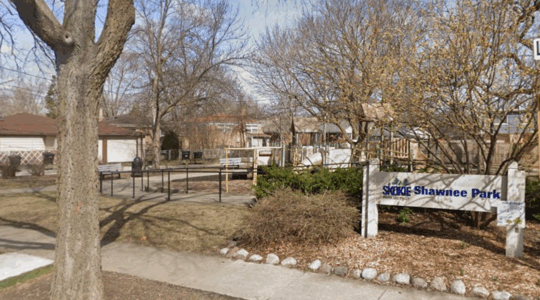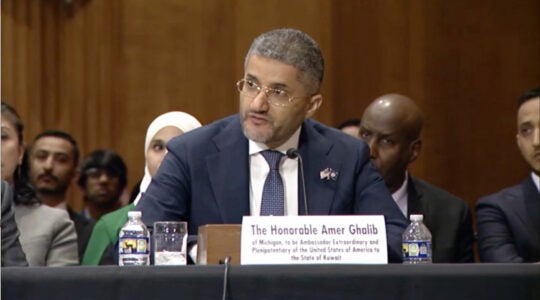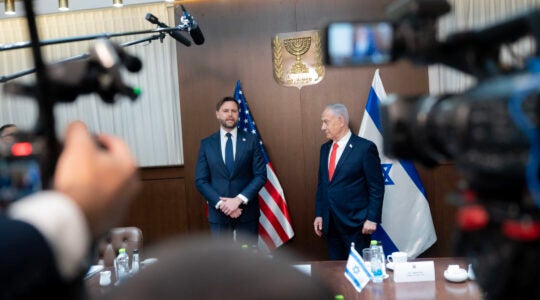WASHINGTON (JTA) — My bat mitzvah invitation had bright purple embossed text on a hot pink card with my name enlarged in decorative script at the top and daisies adorning the bottom.
Twenty-plus years later, I remember eagerly waiting for my friends to receive the invitations and running home weeks later to check the mailbox for the return of the RSVP envelopes. Secured in a scrapbook, the invitation is a treasured memento.
Today, however, a rising trend in simcha invites may be changing the run to the mailbox into a dash for the email inbox and the card stock mementos into computer printouts.
No longer for holiday parties and happy hours only, electronic invitations are becoming an acceptable way for some to announce major life-cycle events, including b’nai mitzvah celebrations and weddings.
When Jason Horowitz, a marketing executive in New York, and his partner, Carl, were planning their February wedding, electronic invitations became the solution for one major concern: They were short on time.
With more than 200 invitations to send, the couple didn’t want to sacrifice style for haste.
Paperless Post, a website launched by a 20-something brother-and-sister team in 2008, was the perfect answer, said Horowitz, 41.
“The wedding was very much planned last minute, but we still wanted to give guests 30 days to RSVP,” he said. Horowitz added that using electronic invitations “saved money and it’s environmentally friendly.”
Paperless Post invitations are sent by email (or through a social networking site such as Facebook or Twitter) with an image of an envelope appearing on screen. The guest’s name can be written on the outside of the envelope in a typeset of your choice, and the inside can include a lining to give the computer image a paper look.
The invitation itself can be designed with the assistance of graphic designers or selected from existing templates.
Having received similar invitations from friends for less formal occasions, Horowitz said, “I loved the concept and thought the aesthetics were much better than Evite.”
Unlike Evite, Paperless Post invitations are not free, but there are also no pop-up ads.
Margery Klausner, an attorney in Southfield, Mich., used an electronic invitation as a follow-up to the paper invitation for her son Nathan’s June bar mitzvah. Klausner, 41, used the image of the paper invitation for the electronic version.
While all local guests and family members received both the paper and electronic invitations, she exclusively sent electronic invitations to guests whom she “wanted to include but wasn’t 100 percent sure that they could come, like those [living] in Israel.”
Dealing with different postage rates and delivery time, she said, was another factor in opting for an electronic invitation.
One of the main advantages to using the electronic invitations was the quick arrival of the responses, said Klausner.
Two hours after hitting the send button on her computer, “I received 57 RSVPs,” she said. Additionally, Klausner was able to track the guests who didn’t open the email and contact them directly to find out if there was a problem.
“It was beyond awesome,” she said. “It’s really impressive.”
Since Paperless Post launched, co-founder James Hirschfeld said, more than 10,000 b’nai mitzvah and 40,000 wedding invitations have been sent over the site.
Calligraphers and engravers shouldn’t worry too much, however. Traditional paper invitations are still very much in vogue, said Wendy Katzen, a Washington-area event planner.
She said that of the dozen or so weddings and b’nai mitzvah celebrations she plans for clients each year, “not one” has opted for an electronic invitation.
For Melissa Kanter, 49, the paper invitations for the December b’not mitzvah of her twin daughters, Emily and Rachel, will “set the tone for the affair.”
“It’s an accessory, like the bracelet to the outfit. It pulls the whole thing together,” said Kanter, an occupational therapist in Short Hills, N.J.
The invitation will reflect the personalities of her daughters, said Kanter, who worked with a graphic designer.
The RSVPs will be with a response card — not directed to an email address — and she’ll create a special postage stamp for the invitations and cards.
After the affair, the invitation will be framed in a shadow box and used to make gifts for the girls — jewelry boxes and pillows.
“I’d rather have the tradition” of a paper invitation, Kanter said. “It will be a keepsake that I’ll put in their baby book.”
Katzen says that in planning a life-cycle event, it’s important to keep in mind that guest lists are often multigenerational and you want to take care not to insult anyone.
“There are still [people] who think a BlackBerry is a fruit,” she said. “You want to keep those guests in the loop, too.”
That wasn’t an issue for Horowitz — even his guests in their 80s had email addresses.
Days before the wedding, he sent a message through the site clarifying the start time of the ceremony. The flexibility of an electronic invitation made it much easier, he said, “otherwise I would have had to make a hundred phone calls.”
With a guest list of more than 1,500, Rabbi Batya Steinlauf, 48, also went the electronic route for her son Noah’s bar mitzvah last December after it was suggested by another mother.
“It was brilliant and made it possible,” said Steinlauf, whose husband, Gil, is the rabbi at Adas Israel Congregation in Washington.
The entire congregation was invited to the bar mitzvah and subsequent kiddush lunch.
The Steinlaufs also went the electronic route for a separate Friday-night dinner for family members and a party on Saturday evening for children.
“Can you imagine sending out 1,500 paper invitations?” Steinlauf asked. “It saved a fortune and saved many trees. There’s no question, I can’t imagine another way to have done this.”
(The LifeCyclist column is dedicated to covering the ways that individuals and families are marking important Jewish milestones in their lives. Please send suggestions for future coverage to LifeCyclist@jta.org.)
JTA has documented Jewish history in real-time for over a century. Keep our journalism strong by joining us in supporting independent, award-winning reporting.





